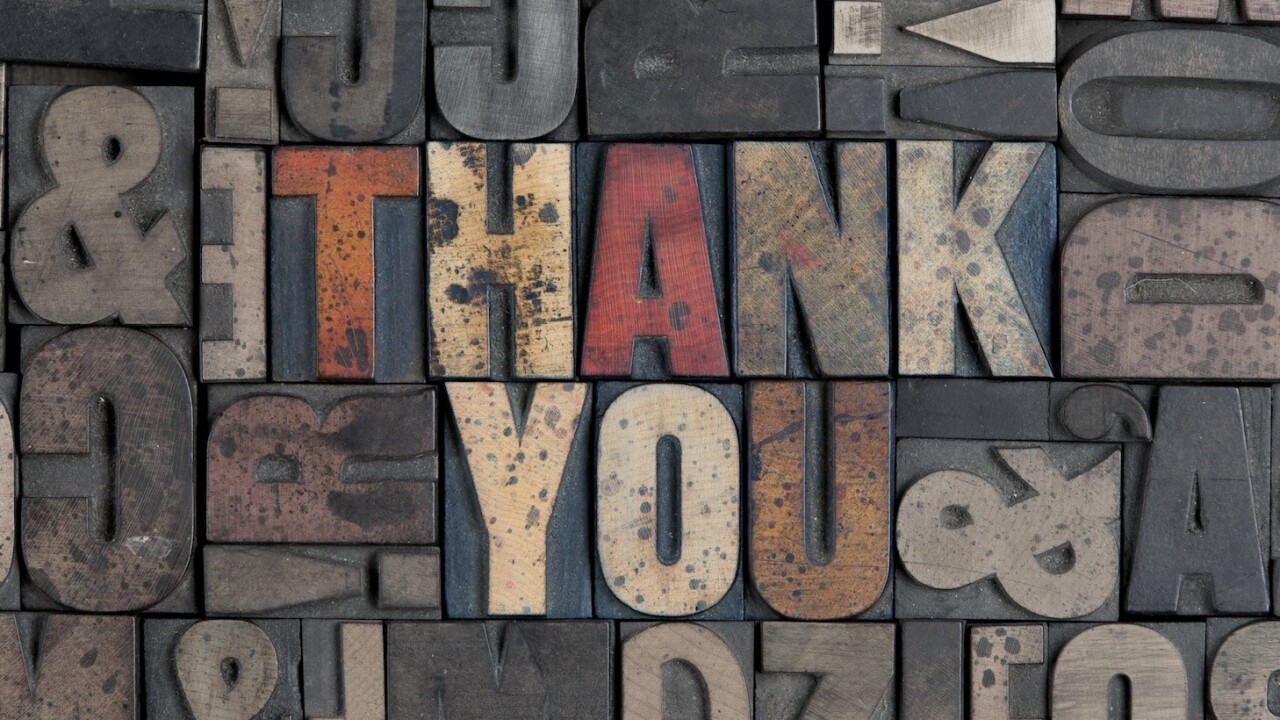
When it comes to website optimization, you’ve probably already taken the necessary steps of creating compelling landing pages, experimenting with headline and CTA formulas, and split testing different on-site elements to ensure maximum conversions.
But there’s one huge resource on your site that’s likely going ignored… your Thank You pages.
Think about it. Every time a visitor purchases a product from your site (or undertakes any other conversion activity you’ve defined), they’re as engaged as they’re ever going to be. They’re feeling confident about their decision and optimistic that the risk they’ve taken in working with you (versus your competitors) will be the answer to their problems. If you were looking to further engage your current customers, there’s almost no better time than your Thank You pages.
If you’re one of the many webmasters ignoring this powerful asset, it’s time to take back your Thank You pages. Any of the following seven strategies will help get you started:
Strategy 1 – Direct them to another page on your site
Sure, sending your post-purchase site visitors to another page on your website isn’t going to do much for your business’s bottom line, but at a minimum, you’re keeping them engaged with your brand. In that time, they may decide to fill out an opt-in or lead generation form, join a webinar they’d missed previously or find a piece of content they like enough to share with their friends.
Here’s how Kissmetrics does it following subscriber opt-ins:
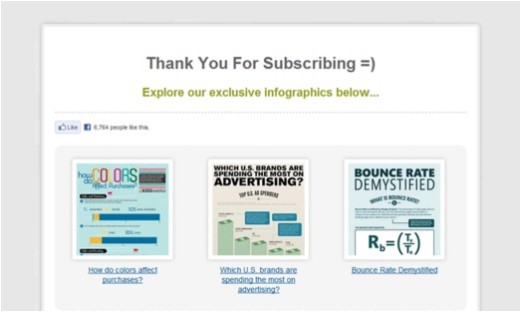
It’s literally the minimum you should be doing, but if any of the strategies below don’t feel like a good fit for your company, make sure you’re using this one.
Strategy 2 – Ask buyers for a social share
If you want to up the ante a bit, use your Thank You pages to encourage buyers to share their purchases with their social followers.
Here’s an example of how email marketing services provider Aweber ties social share encouragement to their post-webinar registration Thank You page:
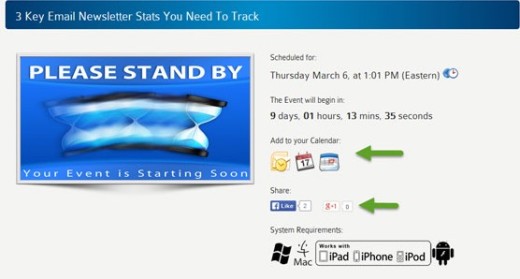
Social share buttons like these can be hand-coded into your website or integrated with a social sharing plugin. Either way, just pair your new buttons with text encouraging Thank You page visitors to take a social sharing action, and you’ve quickly maximized the value of this key site area.
Want to make this type of appeal even more compelling? Take a look at the way KickoffLabs uses leaderboard social scoring to directly tie social shares to product performance:
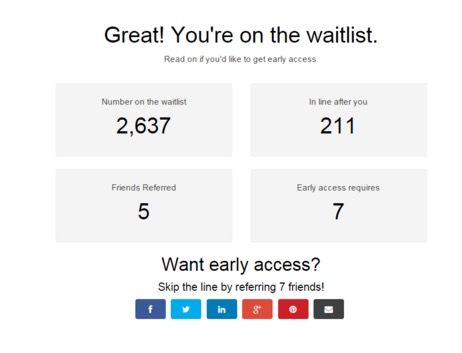
Strategy 3 – Offer a coupon code for a future purchase
Don’t wait to upsell your new customers. Strike while the iron’s hot by using your Thank You pages to offer special offers to those who have just completed their purchases – just as Jigsaw Health has done below:
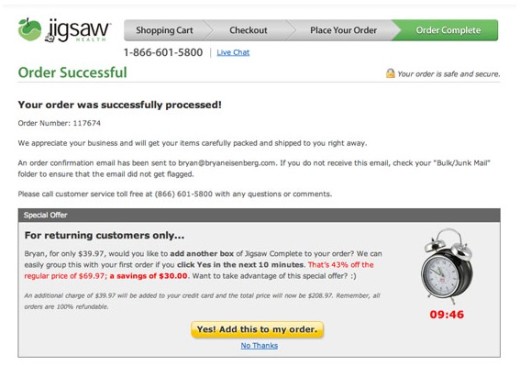
When crafting these offers, keep the basic copywriting principles of scarcity and time sensitivity in mind. Make it clear to page viewers that they’ll only get access to this deal once to boost conversions on your Thank You pages.
Strategy 4 – Invite them to an upcoming webinar
If upselling or cross-selling different products isn’t appropriate for your Thank You pages, you can still encourage engaged visitors to deepen their relationship with you by inviting them to attend your next webinar.
This, in turn, will lead them to another Thank You page where, for best results, you’ll want to follow the lead of the Aweber example given above and embed calendar options into the page to ensure subscribers return again for your presentation.
Strategy 5 – Encourage them to set an appointment
Depending on how you work with customers, one of your final conversion goals may be to encourage visitors to book an appointment with you or your business. And if this is the case, your Thank You pages could be some of your greatest allies.
To capitalize on this strategy, identify the Thank You pages on your site where visitors have taken low commitment steps to engage with your brand (perhaps, to opt-in to your email newsletter or share your website socially). These Thank You pages in particular represent great opportunities for the inclusion of an appointment setting form, as they represent the “next level” step of engaging with your brand.
Strategy 6 – Provide an opt-in opportunity
Newsletter opt-ins are important at every stage of the conversion process, but just because a website visitor purchases from you doesn’t mean that they’ve already subscribed to your email updates. Conversion paths are rarely linear, so don’t assume that they’ve undertaken lower commitment steps before pulling out the big guns with actions like purchases.
The solution? Use your Thank You pages to encourage visitors to opt-in to future newsletters. Here’s what you’ll see on Social Media Examiner after you complete their opt-in form:
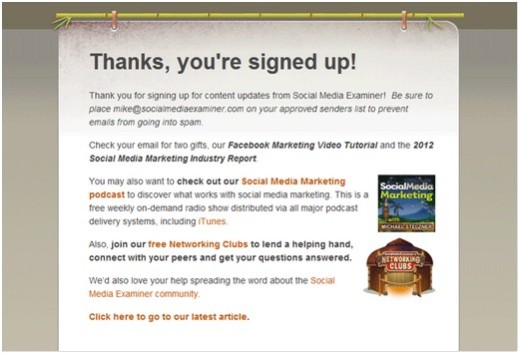
Strategy 7 – Prompt an app download
Finally, if your company offers an app, your Thank You pages represent a great place to make your visitors aware of it and to encourage them to download it. The following video from CLVboost will show you how to do it:
As Andrew Woo, writing for Kissmetrics, argues:
“By putting up the typical boring message, “Thanks for signing up! Stay tuned for…,”you’re giving [visitors] the green light to leave and forget about you. Why not take advantage of the momentum you’ve built and engage them even more?”
If your Thank You pages aren’t earning their keep, it’s time to do something. Give any of the seven strategies above a try in order to maximize your conversions, or adapt them to better encourage the specific actions and goals you’re trying to drive on your site. Experiment with different options and split them for best results.
Until you try, you’ll never know how powerful your Thank You pages can be.
Get the TNW newsletter
Get the most important tech news in your inbox each week.





